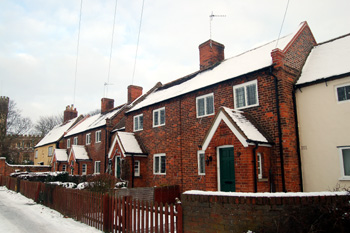The Whitbread Almshouses Cardington
![Elevation of the new almshouses by James Lilburne 1788 [W3709]](/CommunityHistories/Cardington/CardingtonImages/Elevation of the new almshouses by James Lilburne .jpg)
Elevation of the new almshouses by James Lilburne 1788 [W3709]
The Whitbread Almshouses were listed by the former Ministry of Works in May 1952 as Grade II, of special interest. The properties date from 1787. They are built of red brick and have an old clay tiled roof. Each of the four cottages has two rooms upstairs and two down. The listing states that they stood originally in two blocks of two with the blocks being linked in the 19th century by a lower block with a similar extension to the south-east but Lilburne's elevation of 1788 [W3709 - see above] shows that this is not true and that they have always had their current design.
The trust deed establishing the almshouses is dated 14th April 1787 [W3295-3296] and was set up by Samuel Whitbread I who conveyed the houses which he had “lately built” to trustees – his son Samuel Whitbread II, John Howard, John Wingate Jennings of Harlington and John Thompson of Fenlake Barns. As well as building the houses Whitbread had allotted gardens and provided furniture. He also purchased a £78 fee-farm rent in Shillington from Thomas Borrett, which was subject to £10 per annum for a Luton schoolmaster and Land Tax and gave £52 per annum net. This was for the maintenance of the houses. At that time the occupiers were William Dunton and Nathaniel Grant, both widowers and six widows – Mary Bigrave, Ann Field, Susan Green, Ann Stewart, Jemima Ward and Mary Beccles. Clearly each one had a single room upstairs and down. The conditions were that occupants must be single people, widows or widowers of “sober, decent life and conversation” and have regularly attended public worship. They must be sixty years of age or more and have been born in and been resident in Cardington for twenty years. They must “never have received alms of any parish”. Forty shillings per annum each was allowed for coal.
We are fortunate that three surveys of the parish of Cardington from the late 18th century survive. The first of these was undertaken in 1782 by James Lilburne. He was the parish schoolmaster and later agent for Samuel Whitbread, who owned large estates in the parish and also the sole Enclosure Commissioner for the parish. He produced a list of all the inhabitants of the parish arranged by house and hamlet [P38/28/1/1]. This was published, with extensive analysis by County Archaeologist David Baker in 1973 as Bedfordshire Historical Record Society Volume 52.
Since publication a second list has been found [P38/28/1/2]. It carries revisions up to the year 1789. Sadly neither of these surveys includes a map. Finally, in 1794 Lilburne produced another survey [W2/6/1-3] and this one had a map with a key showing where each house was. One can use this to plot the houses of the previous surveys and this work was carried out by John Wood of Bedfordshire County Council’s Conservation Section in October 1982 [CRT130Cardington29].
The 1782 survey [P38/28/1/2] did not mention the almshouses because, of course, they had not yet been built. A cottage divided in two then stood on the site. Half was occupied by John Larkins, aged 32, a labourer who had been born in Cople and his 32 year old wife Hannah, née Pain, who had been born at Riseley. They had four children: Elizabeth, aged nine and John aged six. Both of these are annotated by the word “Sings”. John went to school courtesy of Samuel Whitbread. The two younger children were William aged one year and three months who also went to school, courtesy of John Howard. Presumably this information was added later! James was born on 14th December 1782. A fifth child, Sarah, was born on 15th September 1785. Sadly a son born on 28th February 1788 died un-baptised on 28th April that year.
Next door was Edward Whiteman, miller. He was 29 years old and had been born in Cardington. His wife Mary, née Bets, was the same age and had also been born in the village. Their child was Frances, born in December 1781 who was later sent to school courtesy of John Howard. The survey notes that a child was born dead on 11th June 1783 but a third child, Melicent was born on 7th September 1786. The family moved to another cottage in the village in 1784 and was replaced by George Trueman, a labourer, aged 26 who had been born in Cardington, and his 24 year old wife Hannah, née Tomkins who had been born in Elstow. Their children were Elizabeth, born 24th August 1784, who, sadly, died on 8th October that year, and James, born on 11th April 1788.
The Rating and Valuation Act 1925 specified that every building and piece of land in the country was to be assessed to determine its rateable value. Cardington, like most of the county, was assessed in 1927 and the valuer visiting the almshouses [DV1/C116/15-18] found that two contained a living room, kitchen and two bedrooms, the other tow a living room, bedroom, scullery and store room. The occupants were: Mrs. Handley; Miss M. Houghton; Mrs. Myers and Miss Witty.
 Whitbread Almshouses Christmas Eve 2010
Whitbread Almshouses Christmas Eve 2010